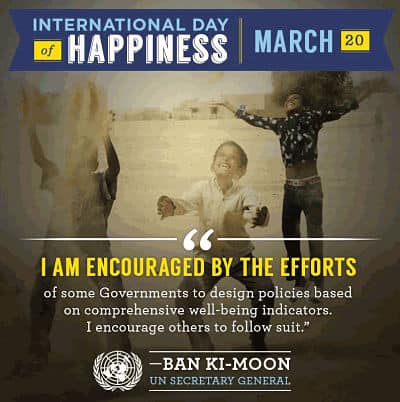Today we have, once again, witnessed the arrival of the World Happiness Reports – reports that claim nothing less than to offer a neatly quantified, ‘objective’ measurement of just how happy we are! What are these reports all about – why are we enticed by the idea that happiness could be measured in any meaningful ways? Allegra’s Miia Halme-Tuomisaari reflects on these thoughts and more in this ‘jewel from Allie’s archive’, originally published in 2014 – at the height of #happy.
*****************************
BECAUSE WE’RE #HAPPY?
Over the past weeks the social media has been flooded with videos of people around the world dancing to William Pharrell’s tune ‘HAPPY’. One of the most memorable videos (shared also by Allegra) is the one from Dubai. However, the title for the video with the most nuanced subtext needs undoubtedly be bestowed on the video featuring students of the Geneva Graduate Institute.
In the video attractive young adults of diverse ethnicities dance in the gorgeous Geneva landscape filled with lush green parks, the beautiful Lac Léman and the breath taking mountains hovering in the background – and as if in concrete mockery of all those currently exposed to less-amicable climates, all are clad lightly (yet smartly) with no woollen scarfs or heavy down coats in sight.
The mood is bright – as is the lighting – with only positive sights in the horizon, both concrete and figurative. Indeed, how could these dancers be anything but HAPPY!
Inevitably the video features also numerous UN buildings – and why not, since the freshly finished new headquarters of the Graduate Institute are only a stone’s throw away from the Palais des Nations. The video shows the spacious and calm surroundings of the Institute located in the nicely elevated part of the town, embodying ‘the international scene’ that the city hosts to the max.
With all this combined, the outcome is the kind celebration of international collaboration and cosmopolitan spirit that is difficult to top. Whether the video is merely the result of spontaneous organizing or part of a premeditated PR campaign is difficult to ascertain, but it certainly succeeded in interpreting the pulse of the social media correctly, thus rightfully finding widespread circulation.
Today the video received significant additional exposure as it was featured in the official UN Facebook page for the International Day of Happiness – a page marking this little known ‘calendar event’ launched by the organization in 2012 to accompany the infinite previously existing special days recognized by the UN.
Indeed, today the UN celebrates Happiness. And of course the organisation has teamed up with William Pharrell.
Although at the surface all of these findings may appear innocent and merely as just that – a celebration of the GOOD and POSITIVE existing in the world and also in between people – a critical observer cannot but pair them with some rather somber undertones. Most followers of the ‘trends’ within international collaboration have likely noticed how, in addition to or even instead of, the more familiar surveys on standards of living, in recent years different ‘studies’ of happiness have been making international headlines as forming the new standard according to which to assess the world.
Two things have been particularly striking thereof. First, the countries commonly topping these ‘studies’ are virtually the same ones prevailing in all the other lists of similar nature – best places in the world to live in, best standard of living, best cities to live in, best places for women & children, highest levels of education etc. More often than not the ‘top 5’ slots go to different countries located in the Scandinavian region – something giving rise to a series of questions on the criteria used in these surveys as well as the purposes for which they are generated in the first place.
Second, few voices have publicly challenged the very exercise of measuring and classifying happiness. Let me thus embody such a voice here. What are these happiness statistics fundamentally about? What does it mean to measure happiness? Happiness how – as in moments of ‘I feel good right now’ or rather in ‘I am content with everything that I have in my life’? Happiness as a perpetual state of being, or rather something that some people – perhaps by some mystery the people of the Scandinavian countries – are more prone to experience collectively than others? Are we thus looking at happiness as the exclusive ‘right’ of a privileged few? Clearly these studies are not accounting for the experiences of all the people who regrettably still for example in Finland suffer from alcoholism, depression or violent behavior – all of which, by the way, are also at record levels in the country when compared internationally.
These realities fail to fit in the new standardized measurements of happiness, and thus they are erased from view. This finding impacts how the consequences of this recent happiness-measuring-fascination appears. From one perspective it contributes to the standardisation and also polarization of the world into predetermined ’emotive states’ where certain criteria classify a person as falling under the category of ‘happy’, and by turn other criteria place the person in the category of ‘not happy’ – or perhaps ‘miserable’. The outcome, nevertheless, is a neat national average that can then travel to international comparisons. Simultaneously all those whose experiences do not find articulations in the existing categories are overlooked entirely. As their ‘unhappiness’ fails to fit into the pre-existing standardized parameters, their experiences are rendered insignificant and non-existent.

As you underprivileged people of the world can now see for yourselves, if you follow our lead you will not only become more prosperous, but also HAPPIER.
From the perspective of the UN celebrating happiness appears perfect on numerous levels. As the difficulty to realize any concrete goals becomes more evident with each new failed resolution, insignificant new initiative and unmet international standard, the organization’s very legitimacy is becoming increasingly vicarious. Here shifting our collective gaze from such past failures to happiness instead does important work. Why remind people of the unreached Millennium goals of which continually growing global inequality has made a virtual travesty when you can celebrate HAPPY people dancing!
And further: as long as the UN can be seen as synonymous with continually greater global happiness, it can – at least to its defenders – also justify its continual existence in the world. Even if it realistically may hold limited ability to inflict much change, at least the ‘will’ of the organization continues to be embedded in desires to make people around the world happier!
And this, in essence, is what the Graduate Institute video embodies: it features people of all colors and races who come together in being happy. This is global collaboration in action – and that it occurs within an educational context, education forming one of the most important mantras for the UN, is ‘pure gravy’! The video is an embodied celebration of diversity. Who cares of the thick layer of objective similarity that any closer examination bestows on the students of the Graduate Institute; who cares if those dancing HAPPILY in the video are really members of a very small global elite (after all, Geneva being one of the most expensive cities of the world to live in, it is otherwise impossible to find means to actually study there. And access to the elite professional space of UN staff is hardly any different).
Interestingly the UN International Day of Happiness was launched in 2012, introducing an undeniable commonality of time between its creation and the recent proliferation of international happiness studies. Would one be a terrible cynic if one wanted to know more of just who are the beneficiaries of the global ‘Happiness Industry’? Just through what processes – by whom, where and how – has ‘happiness’ been elevated into a commodity that can be quantified, measured and thus celebrated?
I bet that somewhere in the world there are people scheming at this very moment on how to tap into the large market potential that ‘happiness’ still entails – are there already ‘Happy International Happiness Day’ cards? For William Pharrell’s team all this must certainly be a PR dream come true. Now if only we knew: which came first, the idea for the song ‘HAPPY’ or the thought to capitalize on the International Day of Happiness?
Who really benefits from this global focus on happiness more: genuine international collaboration as people around the world (or those having access to the kind of internet connections that allows the repetition of online videos) think
YES, I too want to join those HAPPY people dancing and thus make the world a better place – let’s all live in peace and harmony!
Or the CEOs of Global Happiness INC? Is happiness the new opium the promise of which those in power – also in the industry of doing good in the world – want to get the globally underprivileged masses hooked on? Or are these dance videos being distributed and watched just because they make people HAPPY?
I would like to believe in the latter…
In addition to being Allegra’s moderator, MHT LOVES happiness and enjoys collaborating internationally at the UN and the Geneva Graduate Institute. She is a fan of William Pharrell and currently contemplates on releasing her own HAPPY video. Warm thanks to Ninnu Koskenalho for wonderful editorial assistance!
Post Script: Because reality has an ironic sense of humour, this post has since its writing received interesting additional layers as Miia Halme-Tuomisaari was in 2016 a senior visiting fellow at the Graduate Institute. She remains as inspired as ever by the Institute and it’s Maison de la Paix, seeing it as an ideal site for an ethnography of the academia.








One of the things I miss a little in this analysis is some links to data verifying that “the same states topping international happiness surveys” are indeed “also among the world’s most prosperous states”, as this piece claims. It certainly sounds plausible, and it seems to be the basic claim underpinning the rest of the post’s argument, that such rankings are unfairly slanted with the result of making the Northern countries, or the West, look superior, and portraying happiness “as the exclusive ‘right’ of a privileged few”.
I’m only bringing this up because I remember some “happiness research” which showed Ghana coming out quite high and the US low — and the explanation that was given about how it’s equality in income rather than size of income that was driving differences in happiness seemed promising, from a left-wing perspective. That was years ago, though, so I have no link and no guarantee I’m remembering it correctly.
Some Googling, however, led me to the “World Database of Happiness”, compiled by the pioneering Dutch happiness researcher Ruut Veenhoven for the years 2000-2009 (and sadly presented in web design from before that). It shows the highest mean levels of happiness being reached in some Northern countries (Denmark, Iceland and Finland) but also, interspersed with them, Costa Rica and Mexico. Sweden ranked below Panama, and the US below Venezuela. Another (more recent?) iteration of the same database, data of which were included as appendix in a paper on “Income inequality and happiness in 119 nations”, has Colombia and again Mexico ranking at the top, right alongside Switzerland and Denmark. Those data seem to contradict what this post is saying, which is why links to representative examples would have been useful to verify the author’s claim.
If the results of “happiness research” do indeed suggest that it might be income equality as well as prosperity that plays a determinant role, it might actually make this discipline a potentially useful line of research for leftist academics. My quick bit of Googling also threw up a piece by American psychologists which found a correlation between the growth of income disparity in the U.S. and “a marked drop in life satisfaction and happiness.” It also lead to a paper called “Inequality and Happiness: A Survey”, in which the authors reviewed “the papers that estimate or examine the relationship between inequality and self-reported happiness” and found that “inequality reduces happiness in Western societies,” at least, though “the evidence for non-Western societies is more mixed and less reliable”.
This note about how income inequality may depress people’s happiness in some parts of the world but not in others seems to recur elsewhere too. “in the Western world, [..] we found a strong negative relationship between income inequality and happiness, even after controlling for wealth,” wrote Berg and Veenhoven, but “in Eastern Europe the picture is quite different: after controlling for wealth, there is a slight positive relationship between income inequality and wealth. The same applied for Asia and Latin America”. They actually seem to end up concluding that “for the average person the benefits of income inequality seem to somewhat outweigh the downsides,” which is not a helpful finding if you’re an advocate of increased equality. As the authors point out, however, that conclusion concerns inequality on a national, rather than on a more viscerally visible regional or local scale – and it’s about the average person.
The latter is important because, as another paper by Tomi Ovaska and Ryo Takashima concludes (just judging on the abstract, mind you), there can be great inequalities in happiness that are hidden by such an average, and such “inequalities of well-being” are highly correlated with “inequalities in individual incomes and quality of health, and the level of institutional qualities”. Another article by John Ifcher and Homa Zarghamee about 26 countries, judging on the abstract, also found that inequalities in well-being within a country (which might undermine the interpretative value of the country’s average result), decreases as economic growth increases. Results of research by Néstor Gandelman and Rafael Porzecanski, meanwhile, were on the one hand “in line with earlier studies that found only a modest correlation between income and happiness” overall — but did find that greater income inequality within a country leads to greater inequality in happiness as well.
All in all, it seems that “the very exercise of measuring and classifying happiness,” which this post so criticizes, might have more to offer than the kind of whitewashing of a hegemonic Northern perspective this post seems to make it out to be. In fact, not to be too critical, but I’m thinking that the post would have benefited from a somewhat greater curiosity about what happiness researchers have already said themselves about the questions it raises. The post asks a series of questions starting with: “What are these happiness statistics fundamentally about? What does it mean to measure happiness? Happiness how [..]?” — but I feel like I’ve read pieces from and about happiness research that queried and discussed all these questions quite diligently, as you’d expect in a relatively new and growing discipline.
For example, the post specifically raises the question of how Finland can come out near the top, arguing that “Clearly these studies are not accounting for the experiences of all the people who regrettably [..] suffer from alcoholism, depression or violent behavior” in the country. But is that really all that clear? The post goes as far as saying that those who deviate from the “neat national averages” in “the pre-existing standardized parameters” are “erased from view” and “rendered insignificant and non-existent.” But as the above shows, a bit of Googling at least appears to reveal that happiness researchers have in fact questioned the problems concerning findings about averages, and the substantial divergences from the average that exist within countries, quite extensively.